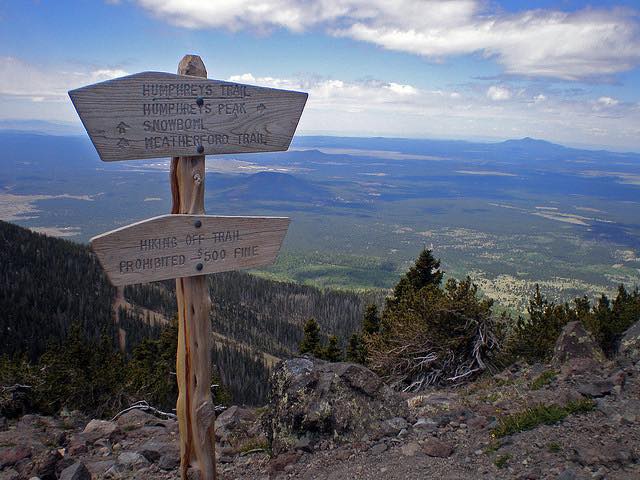During the upcoming Memorial Day Weekend and throughout the summer, visitors to Arizona’s highest point, Humphreys Peak, will notice a new group of volunteers greeting hikers at the trailhead. The Preventative Search and Rescue Project volunteers will ask questions about visitors’ preparedness for the rigorous climb, in an effort to reduce rescue manpower-intensive rescue efforts. and offer suggestions for alternative trails when appropriate.
The idea for the Preventative Search and Rescue Project came out of an NAU wilderness management class taught by forestry professor Marty Lee. “The class projects are experiential learning that might lead to real change and also give students the chance to interact with land managers,” Lee said.
Volunteers and land managers from various agencies regularly attend Lee’s class to discuss wilderness issues. A major concern has been the number of hikers who get injured or stranded on northern Arizona’s mountain peaks, requiring extensive rescue efforts.
Combatting these issues led to the Preventative Search and Rescue Project, overseen by the volunteer group Friends of Northern Arizona Forests.
“This project is about educating visitors, some who come up from the Valley and want to climb Arizona’s highest peak,” said Laura James of the Coconino National Forest. She and colleague Brian Poturalski, an NAU forestry alumnus, worked with Lee’s students, providing statistics and information about trail use on the national forest.
Aaron Dick, a search and rescue coordinator with the Coconino County Sheriff’s department, said the multi-agency collaboration with NAU students and professor Lee may lead to a reduction in rescue efforts this summer.
“We see a lot of unprepared hikers heading up Humphreys, a physically demanding trail,” Dick said. “Many people are coming from urban areas where they call 911 and the response is quick. When someone has an emergency at the Humphrey’s Peak saddle, it can take two to three hours for emergency workers to reach them so people need to be prepared to take care of themselves during that time.”
Volunteers with the Preventative Search and Rescue Project will check to see if hikers have at least one gallon of water per person, rain gear, GPS devices, proper footwear and adequate food. When visitors are curious about nearby alternative hikes, group members will share a list of other trails.
If the project is successful at reducing the need for rescue efforts on Mount Humphreys, some organizers said the program could be expanded to include the popular Fat Man’s Loop Trail on Mount Elden.



